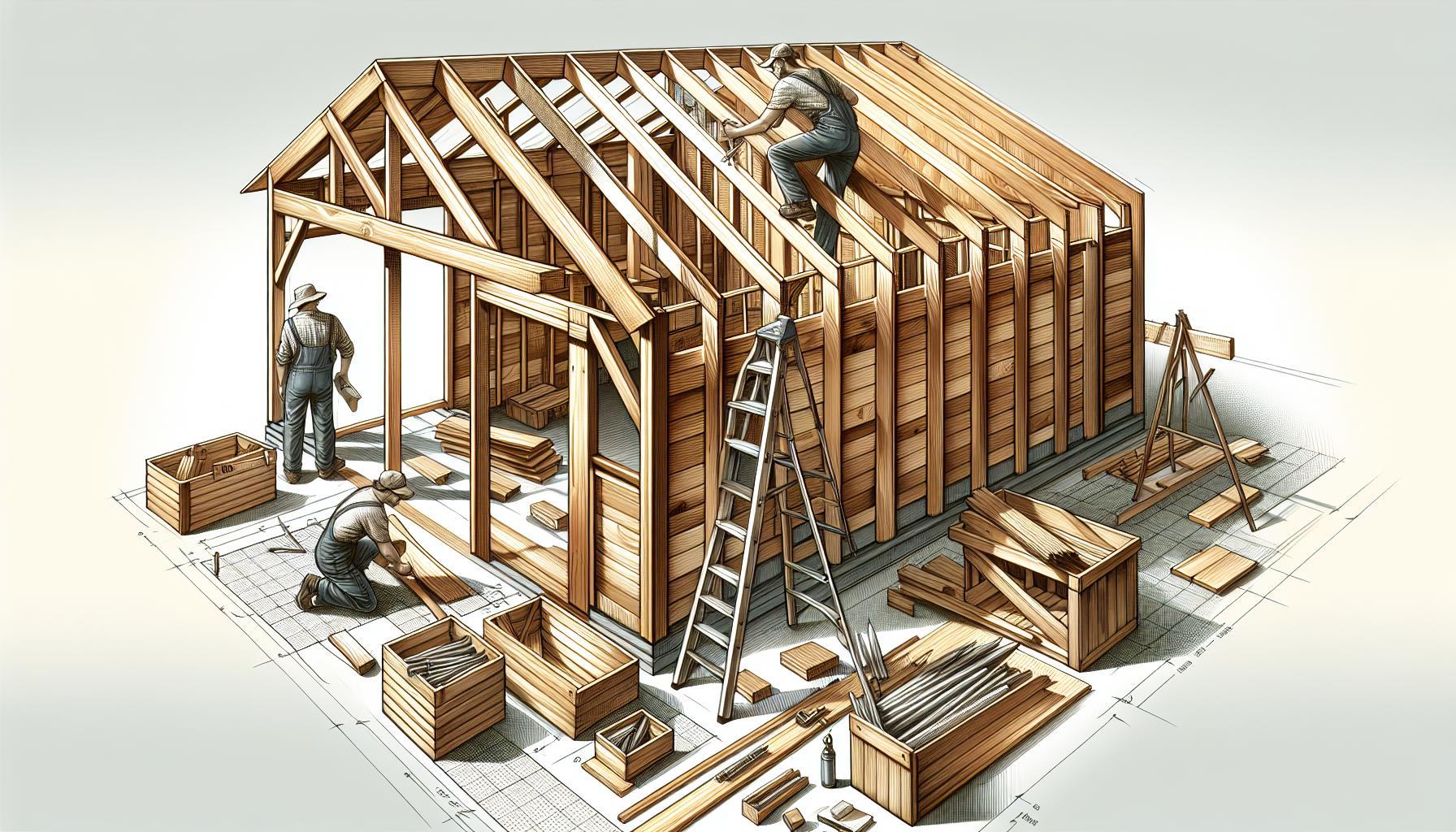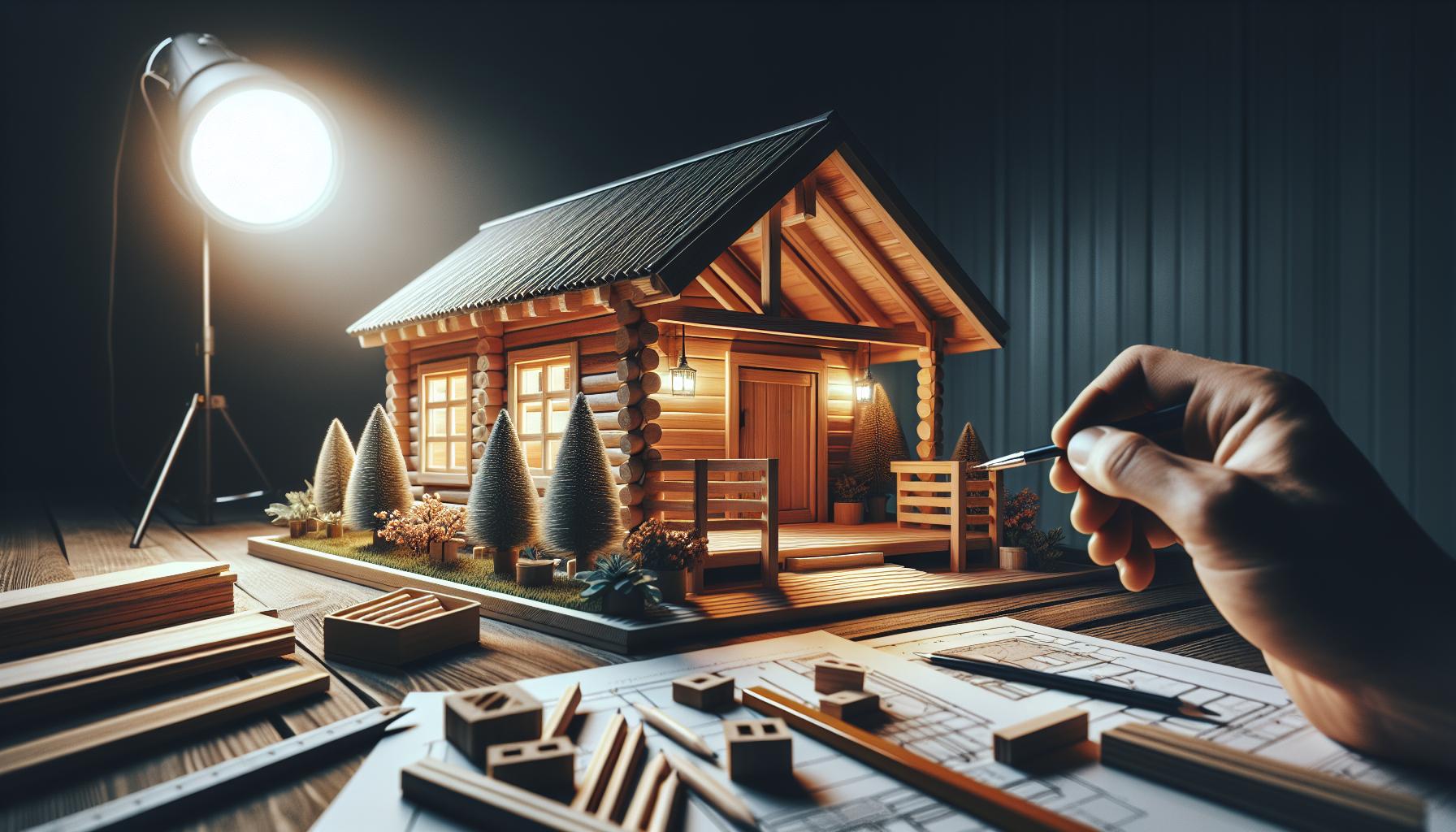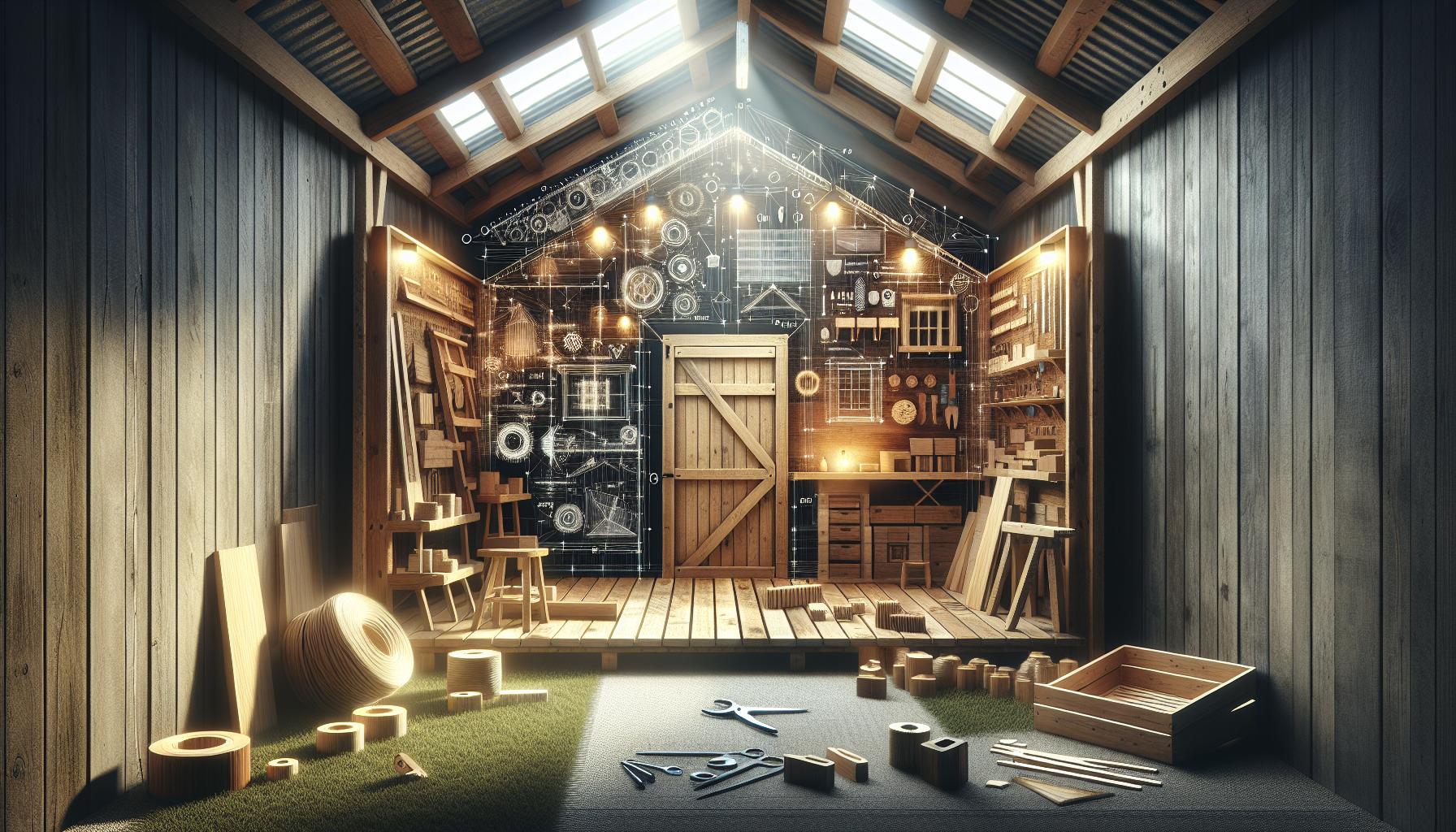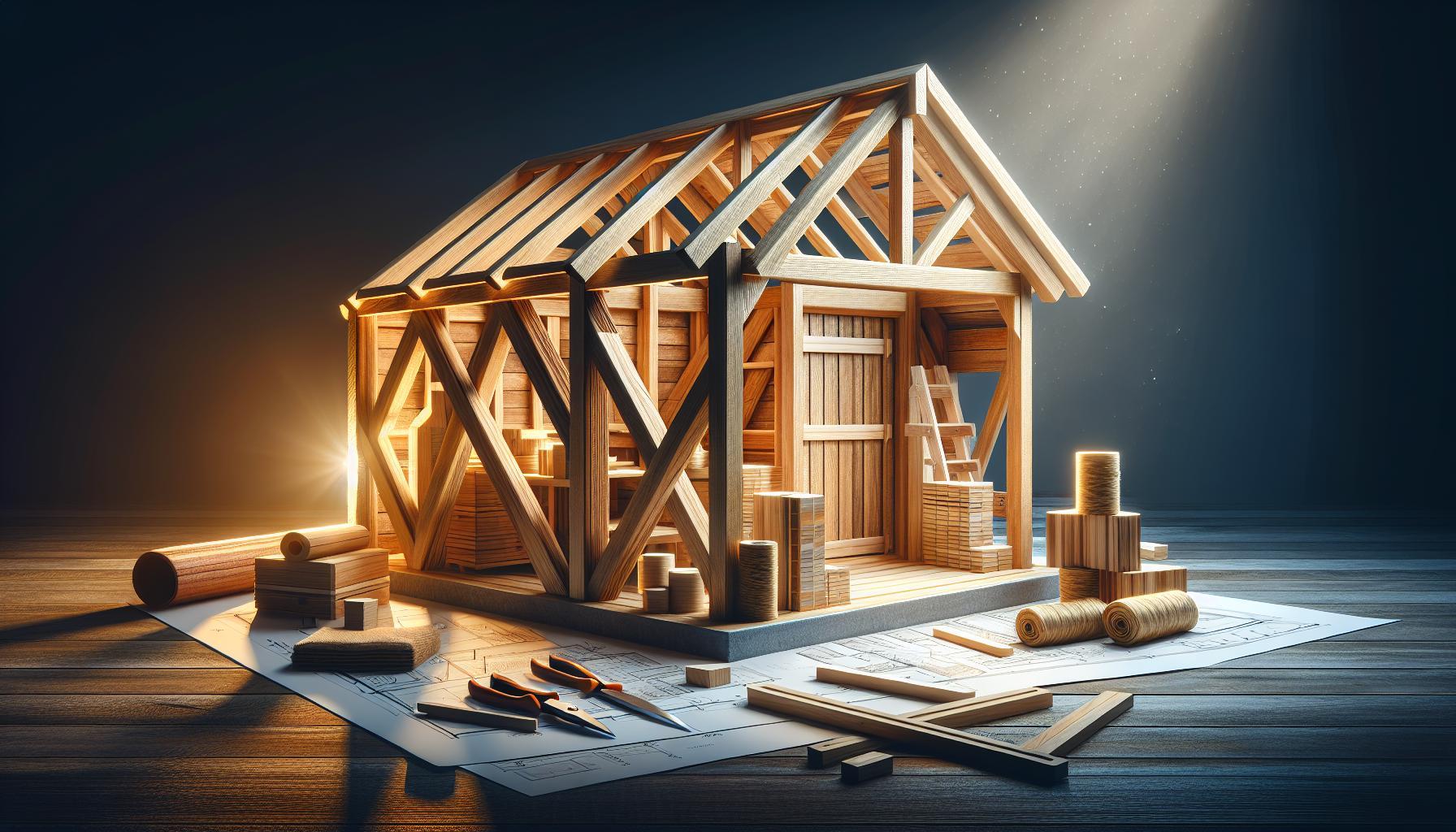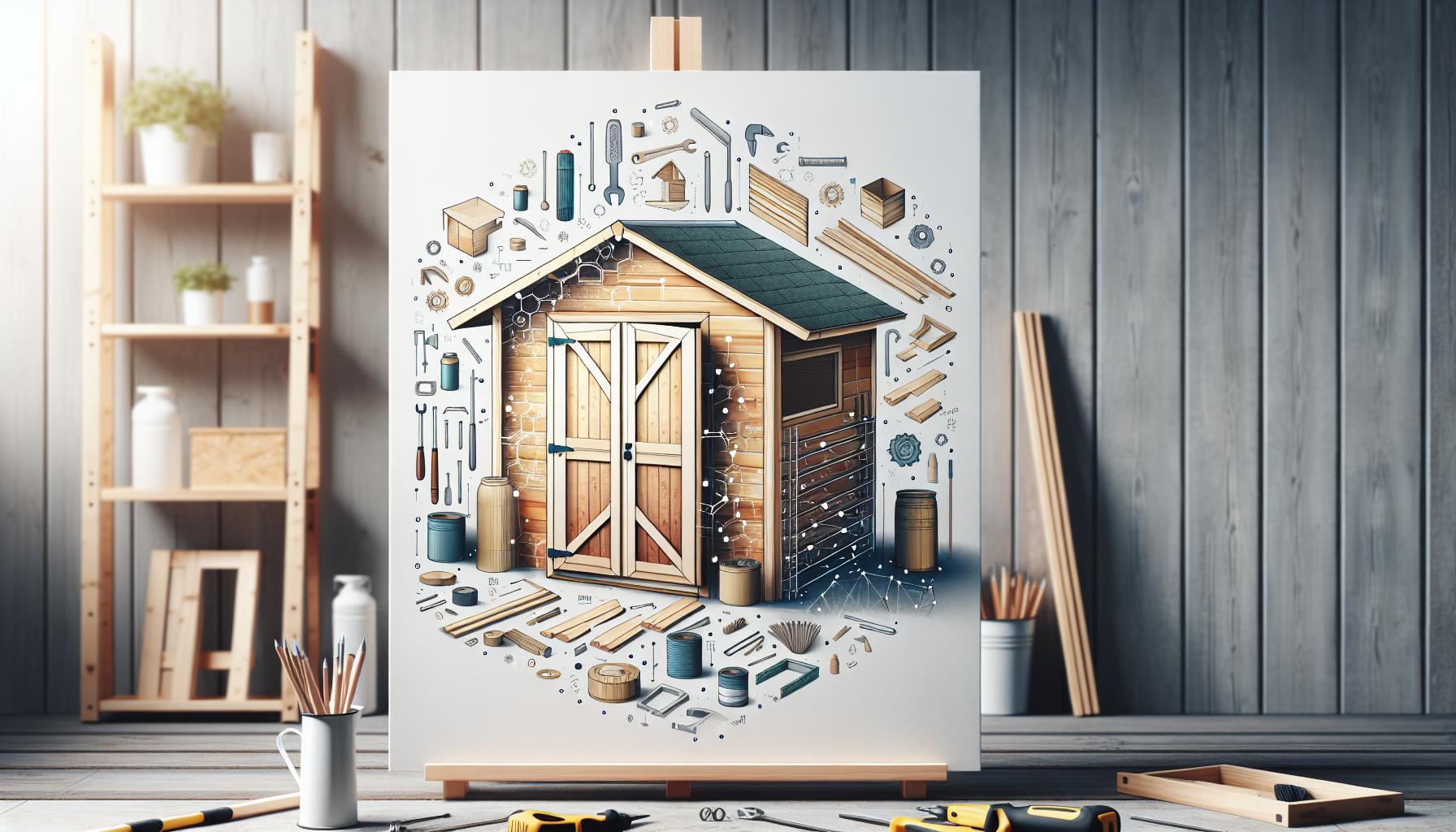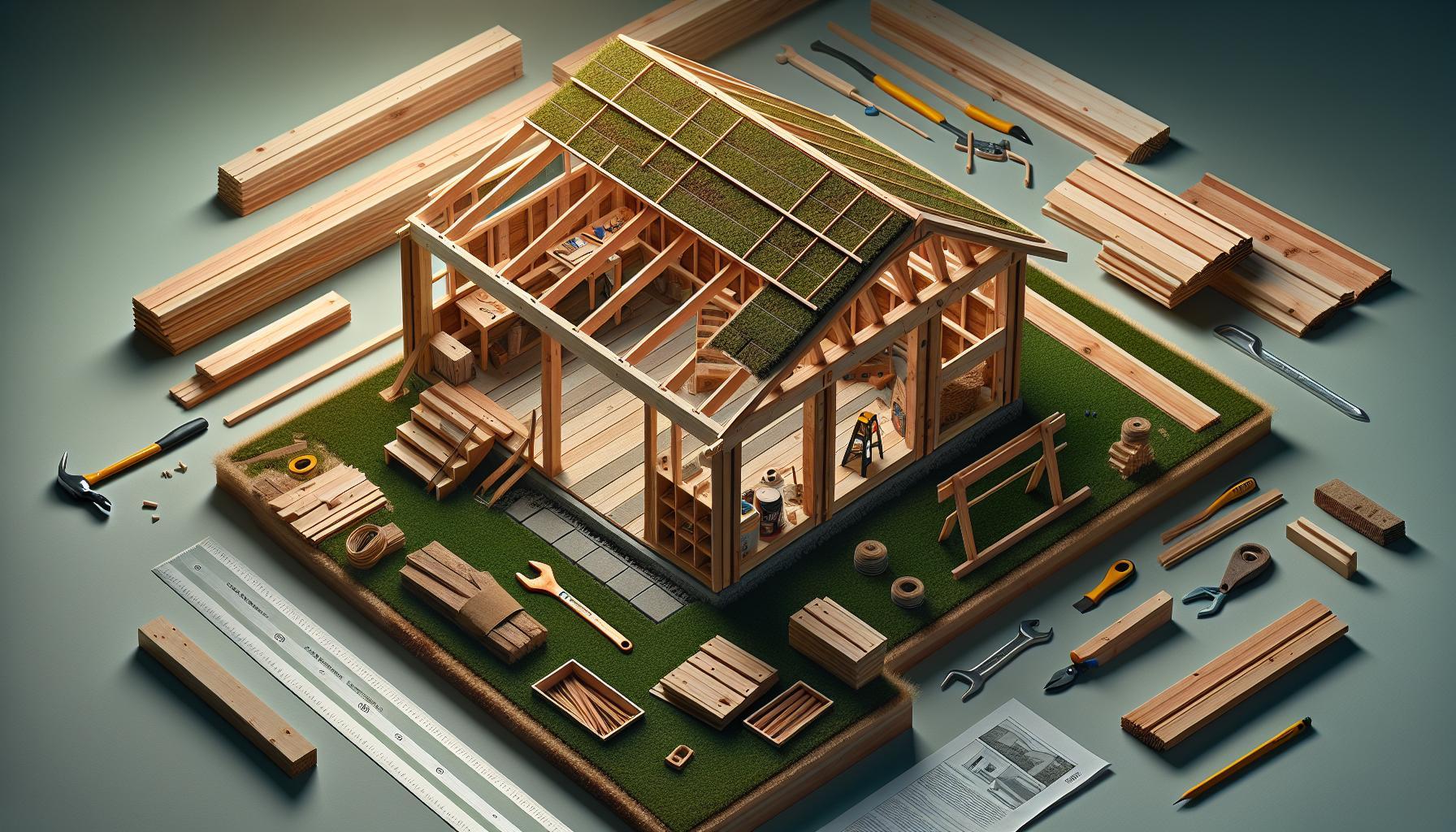Struggling to declutter your yard or garage? Building a storage shed can be a game-changer, adding extra space and organization to your outdoor area. This ultimate guide simplifies the process for first-time builders, providing step-by-step instructions, essential materials, and expert tips to ensure your project is a successful and rewarding venture.
Choosing the Right Location for Your Shed: Space and Accessibility Considerations
When it comes to building a storage shed, the success of your project can hinge substantially on the shed’s location. Selecting a suitable spot is more than just a matter of finding empty ground; it involves carefully weighing various factors such as space,accessibility,and the potential impact on your property. A well-placed shed can enhance your yard’s functionality and aesthetic appeal, while a poorly chosen location can lead to future headaches.
Assessing Available Space
Before you start laying out plans for your shed, take stock of the space you have available.Consider the following aspects to ensure your storage solution is practical and effective:
- Dimensions: Measure the total area where you plan to build. Keep in mind that you’ll need extra room not just for the shed itself,but also for easy movement around it.
- Proximity to Other Structures: Assess how close the shed will be to your home, fences, trees, and other buildings.Ideally, you want to avoid placing it too close to trees that might drop debris or to structures that may cause shadowing.
- Sunlight and Drainage: Ensure that your chosen spot gets adequate sunlight (if your shed will house plants or items sensitive to moisture) and is on level ground with good drainage to prevent water accumulation.
Prioritizing Accessibility
Just as important as having enough space is ensuring that your shed is easily accessible. Think about how you will use the shed and the access requirements involved. Here are some key considerations for location based on accessibility:
- Pathways: Ensure there are clear paths leading to your shed. Ideally, these should be free of obstacles and wide enough to fit any equipment you plan to use for moving items in and out.
- Vehicle Access: If you plan to store larger items, like gardening equipment or bicycles, consider how vehicles will access the shed. Building near a driveway can facilitate easy transport of larger objects.
- Visibility: Position the shed in a location that makes it easy for you to see and access during your routine activities.This can help deter theft and vandalism while ensuring that you remember what is stored inside.
Table: space and Accessibility Decision Factors
| Factor | Considerations | Impact on Shed use |
|---|---|---|
| Dimensions | Measured area, room for movement | Ease of access and storage capacity |
| Pathways | Clear, direct routes | Accessibility and convenience |
| Drainage | Level ground, away from puddles | Protection from moisture damage |
| Visibility | Strategic placement for surveillance | Deter theft and facilitate upkeep |
By carefully assessing the space and ensuring easy accessibility, you contribute significantly to a successful shed-building experience, as detailed further in this guide on how to build a storage shed.
Essential Tools and Materials: What You’ll Need for Your DIY Project
When embarking on your journey to build a storage shed, having the right tools and materials at your fingertips can make all the difference in transforming your vision into reality. Equipping yourself with quality equipment not only streamlines the construction process but also enhances the longevity of your shed.Here’s a detailed overview of what you’ll need to successfully tackle your project.
Essential Tools
Investing in quality tools is a smart move for any DIY enthusiast. Here’s a complete list of must-have tools for building a storage shed:
- Measuring Tape: Precision is key! Use at least a 25-foot measuring tape for accurate measurements.
- level: A bubble level ensures your structure is perfectly horizontal or vertical, critical for a sturdy finish.
- Square: A carpenter’s square helps in crafting right angles, essential for framing and layout.
- Power Drill: For easier assembly, a cordless power drill saves time and effort while making holes and driving screws.
- Saw: A circular saw is ideal for cutting larger boards, while a miter saw can assist with angled cuts.
- Hammer: A good, solid hammer is still vital for driving nails and making adjustments on the fly.
- Pry Bar: Useful for adjusting frames and removing nails, a pry bar enhances efficiency during assembly.
- Safety Gear: Don’t ignore your safety! Durable gloves, goggles, and a dust mask are essential for protected work.
Materials You’ll Need
Gathering quality materials is essential to ensure your shed is sturdy, weather-resistant, and built to last. Depending on your design, here’s a basic list of materials you may need:
| Material | Purpose |
|---|---|
| Wood (Plywood, 2x4s, etc.) | Used for framing, walls, and roof construction. |
| Nails and Screws | Fastening components securely together. |
| Roofing Material (Asphalt shingles, metal panels) | Protection against the elements and insulation. |
| Exterior Paint or Stain | Adding durability and aesthetic appeal to the exterior. |
| Foundation Blocks or Concrete | Providing a stable base for your shed to rest on. |
Before starting, consider creating a detailed materials list based on your shed’s design, utilizing the ‘How to Build a Storage Shed: ultimate Guide for First-Time Builders’ to help ensure you don’t overlook any components.Proper planning and preparation will set the stage for a seamless building experience, allowing you to focus on crafting the perfect storage solution.
Step-by-Step Planning: Designing Your Shed with Purpose and Precision
To embark on a successful shed construction project, meticulous planning is essential. This process not only enhances the functionality of the shed but also ensures it fits harmoniously within your outdoor space. Before diving into the construction phase, consider a variety of factors that will impact your design, from its purpose to its aesthetics and dimensions. A well-designed shed can serve multiple functions, such as a storage space for gardening tools, an aesthetic garden feature, or even a cozy workspace.
Establishing Your Shed’s Purpose
The first step in your planning should focus on determining the primary use of your shed. Understanding its purpose is crucial in deciding the size, layout, and features. Some common functions include:
- Garden storage: Ideal for tools, pots, and fertilizers.
- Workshop: A designated area for DIY projects and craft activities.
- outdoor office: A quiet space for productivity outside your home.
- Kid’s play area: A fun zone for children to play and explore.
By selecting a singular focus, you’ll streamline decisions regarding design specifications, such as shelving, workbenches, or light fixtures, tailored specifically to meet the needs of that function.
Choosing the right Size and Location
With a clear purpose in mind, the next consideration is sizing and placement. You’ll want to measure the intended area to understand how much space is available without overwhelming your yard. Keep in mind any potential legal restrictions or homeowner association guidelines that might require permits for larger structures. Here’s a simple table to guide you in selecting an appropriate size:
| Size (ft) | Ideal Usage | Considerations |
|---|---|---|
| 6×8 | Basic garden storage | Limited but sufficient for small tools |
| 10×10 | Workshop or storage | Ample space for larger tools and workbench |
| 12×16 | Multi-purpose | Good for office, storage, and workspace |
Consider the sun’s path, wind patterns, and accessibility when selecting the location. Placing your shed in a sunny spot can keep it dry and warm, while a shaded area may be preferable for a workspace or kids’ play area.
Integrating Design Aesthetics
Once you settle on the usage and dimensions, think about how your shed will fit into your overall landscape. Selection of materials, roof style, and colors can vastly impact your shed’s appearance. Whether you choose a classic gable roof, a contemporary lean-to design, or a rustic wooden structure, ensure that it complements your existing architecture and enhances the visual appeal of your yard.
Ultimately, by methodically planning your shed’s purpose, size, location, and aesthetic, you set a solid foundation that simplifies the building process and maximizes your satisfaction with the completed structure.This precision in design is an integral part of the journey on how to build a storage shed effectively as outlined in the ultimate guide for first-time builders.
Building the Foundation: Establishing a Strong Base for Longevity
Establishing a solid foundation is a crucial step in constructing a durable storage shed, ensuring it withstands the test of time and environmental conditions. Without a robust base, even the finest materials and craftsmanship can succumb to issues such as moisture damage, shifting ground, or rot. For first-time builders,understanding the guidelines for a strong foundation is essential in the overall process outlined in the ultimate guide for building a storage shed.
Types of Foundations
There are several foundation types to consider when erecting your storage shed, each suitable for different locations and shed sizes. The moast common types include:
- Concrete Slab: Provides a solid, stable base and is particularly effective in areas with heavy rainfall or snow. It requires digging and pouring concrete, making it a bit more labor-intensive.
- Wooden Skids: Ideal for portable sheds, this method involves placing the structure on treated wood beams that are laid on the ground. It allows for easier relocation.
- Concrete Blocks: This option entails using concrete blocks to elevate the shed off the ground, providing good airflow and protecting against moisture.
- Gravel Pad: A simple and affordable choice, a gravel pad facilitates drainage while allowing the shed to rest flat, though it may not be as durable as other options.
Preparing the Site
Before you can lay your foundation, thorough site preparation is necessary. Ensure the ground is level and clear of debris, rocks, and vegetation. This can be achieved through:
- Clearing the area of any weeds or grass.
- Using a level to check the ground, and if uneven, make adjustments by either digging out high spots or adding fill to low areas.
- Marking the outline of your shed to visualize the space it will occupy.
Maintaining proper drainage around the foundation is also essential.this can be accomplished by slightly sloping the ground away from your shed to prevent water accumulation, which could lead to structural issues down the line.
Building the Foundation
Once your site is prepared, it’s time to construct the foundation. Here are some essential steps to follow, depending on the type of foundation chosen:
- For concrete slab:
– Dig a perimeter trench to establish the footing.
– Set up forms and pour concrete, ensuring it is leveled and allowed to cure properly.
- For wooden skids:
- Position the skids parallel to the shed’s length, spacing them appropriately based on the size of your structure.
- For concrete blocks:
– Lay the blocks in a grid formation, ensuring they are level before placing the shed on them.
- For a gravel pad:
- Level the area and fill it with gravel to create a compacted, smooth surface.
Irrespective of the method chosen, double-check the levelness before proceeding with the construction of the shed itself. A solid foundation not only enhances longevity but can also increase the overall value of your shed, making it a worthwhile investment as you navigate your journey in building a storage shed.
Framing and Structure: Constructing the Walls and Roof with Confidence
Building a solid storage shed isn’t just about the materials; it’s about the framing and structure that will ensure its longevity and stability.The framework serves as the backbone of your shed, dictating not only its strength but also how well it stands up against weather elements and time. Whether you’re a first-time builder or someone with prior experience, understanding the key components of constructing walls and a roof can alleviate concerns and bolster your confidence as you embark on this DIY journey.
Starting with the Walls
The walls of your shed are essential in providing structural support and defining the overall aesthetic. Here’s a concise breakdown of the steps involved in constructing your walls:
- Material Selection: Choose between wood framing or metal studs based on budget and desired durability.
- Measure and Cut: Precise measurements are crucial. Use a square to ensure that your wall frames are square.
- Assemble the Frames: Begin by creating a rectangular frame with vertical studs spaced 16 to 24 inches apart. Secure using screws or nails.
- Add Sheathing: Attach plywood or oriented strand board (OSB) to add strength and support insulation,if needed.
When framing your walls, always keep local building codes in mind, as they can dictate specific requirements regarding spacing, height, and materials. The choice of materials can significantly influence the cost of your shed,so conduct thorough research as detailed in the comprehensive guide on how to build a storage shed.
Roof Construction Essentials
Once you have solid walls in place, it’s time to focus on the roof, which not only protects your shed’s contents but also adds character to its design. follow these structured steps to create a robust roof:
- Choose a Roof Type: Decide between flat, gable, or shed-style roofs. Gable roofs are popular due to their effective water drainage capacity.
- Gather Roofing Materials: Common materials include shingles, metal roofing, or rubber membranes. Choose based on both climate and cost.
- Build Roof trusses: Pre-fabricating the trusses can save time. Ensure they are evenly spaced and fitted snugly on top of the walls.
- Install Sheathing: Just like the walls,your roof will need sheathing. Plywood or OSB works wonders here, providing a sturdy base for your roofing material.
The roof frame must be secure and properly sealed to prevent leaks and heat loss.For added insulation, consider placing an insulating barrier before laying down the final roofing material. Understanding practical techniques and strategies can significantly streamline the process and yield professional-looking results.
| Roof Types | Advantages | Disadvantages |
|---|---|---|
| Flat Roof | Easy to construct, cost-effective | Poor drainage, can accumulate water |
| Gable roof | Good drainage, iconic design | More complex design and installation |
| Shed roof | Simpler structure, good for small sheds | Less storage space for tall items |
Constructing the walls and roof of your storage shed is a rewarding and empowering endeavor. Taking the time to understand the critical elements of framing and structure will not only enhance your building skills but will also ensure that your shed stands strong against the elements for years to come. By adhering to the techniques shared here, you’ll be well-equipped to tackle the project with confidence and efficiency.
Finishing Touches: Enhancing Aesthetics and Functionality
Building a storage shed is an investment not just in space but also in the aesthetics of your property.Adding the right finishing touches can transform a plain structure into a stunning addition to your yard. These details not only enhance the visual appeal but also improve functionality, making your shed more enjoyable and efficient.
Choose the Right Exterior Finish
Selecting a suitable exterior finish is essential. Options like vinyl siding, wood stains, or paint can significantly influence your shed’s look. For instance,high-quality weather-resistant paint not only beautifies your shed but also protects it from the elements. When considering aesthetics, opt for colors that complement your home’s exterior, creating a cohesive look across your property.
- Vinyl Siding: Low maintenance and available in various styles.
- Wood Stains: Highlight the natural beauty of wood while providing protection.
- Paint: A wide range of colors to match your home’s theme.
Add Functional Accessories
Accessorizing your shed can significantly boost its functionality. Consider installing shelves, pegboards, or storage bins to keep tools and equipment organized. These enhancements not only use vertical space efficiently but also reduce clutter, making it easier to find items when needed.
For gardeners, adding a potting bench or hooks for hanging tools can turn your shed into a mini gardening hub. A well-designed interior ensures that you can enjoy your shed’s full potential.
Implement Practical Landscaping
Don’t overlook the surrounding area of your shed when focusing on aesthetics.Thoughtfully designed landscaping can make your shed blend more naturally into your yard. Planting shrubs, flowers, or laying down a path can enhance the overall appearance.
When planning landscaping, consider the following:
| Feature | Benefits |
|---|---|
| Pathway | Creates easy access and enhances visual appeal |
| Flower Beds | Adds color and softens the shed’s appearance |
| Overhanging Plants | Provides shade and a natural look |
By integrating these finishing touches, you’ll create a storage shed that reflects your style while offering the practical benefits you need. Whether it’s through color choices, interior organization, or landscaping, the right enhancements can elevate your structure, making it a functional and attractive addition to your property.
Navigating Common Challenges: Troubleshooting Your Shed Build
Building a storage shed can be a rewarding endeavor, but as with any DIY project, challenges are often part and parcel of the experience. From unexpected weather changes to miscommunications in measurements, navigating these issues is essential for a successful outcome. Understanding common obstacles and how to effectively troubleshoot them can definitely help streamline your build process and save you time and frustration.
Weather-Related Setbacks
One of the most common hindrances when constructing a shed is unpredictable weather. A sudden rainstorm or delayed heat can derail your timeline. Here are some tips to mitigate these challenges:
- Check the Forecast: Before starting your project, always check the upcoming weather conditions. Plan your build days accordingly to avoid working in rain or extreme temperatures.
- Prepare Ahead: gather all necessary materials and tools before starting your shed. This preparation can save time in case of unexpected weather, allowing you to work swiftly when conditions are favorable.
- Cover Your Build: Use tarps or canopy tents to protect your materials and workspace from rain and direct sunlight.
Measuring and Cutting Errors
Accurate measurements are crucial in shed construction. A small error can lead to important problems down the line. To ensure precision:
- Double-Check Measurements: Always measure twice and cut once. Utilize a reliable level and measuring tape to ensure accuracy.
- Consider Template Guides: Create templates for repetitive cuts, especially for items like rafters or floor joists, to maintain consistency.
- Use Digital Tools: Consider using apps or software designed for DIY building projects that can assist in planning and visualizing your shed build.
Structural Issues
Once the foundation is laid, structural problems may arise, such as uneven flooring or misaligned walls. To address these concerns:
- Inspect the Foundation: Ensure that your foundation is level and secure. Use a level to check every significant point before you progress further.
- Adjust As You Go: If you notice alignment issues while framing, don’t hesitate to make minor adjustments as necessary to ensure everything fits snugly.
- Reinforcement: Consider adding extra supports or braces if your design requires it, especially in windy areas where stability is vital.
| Common problems | Solution |
|---|---|
| Water Leakage | Install proper flashing and overlap roofing materials to direct water away. |
| Doors Not Aligning | Check hinge placement and adjust the frame accordingly for a proper fit. |
| Wood Warping | Use treated lumber and store your materials in a dry place before usage. |
By anticipating these common challenges and employing proactive strategies to address them, you will greatly enhance your experience while following the tips laid out in the ultimate guide for first-time shed builders. With the right preparation and problem-solving mindset, you can transform potential setbacks into manageable solutions, allowing you to enjoy the satisfaction of completing your project successfully.
Maintenance Tips for Longevity: Caring for Your shed After Construction
Keeping your newly built storage shed in prime condition is just as crucial as the construction process itself. Proper maintenance not only extends the life of your shed but also preserves its aesthetic appeal and enhances its functionality. Just as the guidelines in the *How to Build a Storage Shed: Ultimate Guide for First-time Builders* emphasize quality materials and proper construction techniques, maintaining those elements will ensure your investment remains in excellent shape.
Regular Inspections
routine checks are vital for identifying minor issues before they develop into costly repairs. Aim to conduct inspections at least twice a year, ideally in early spring and late fall. During these inspections, look for:
- Roof Damage: Check for missing shingles, leaks, or signs of wear.
- Wood Rot: Examine the wood for any signs of rot or insect infestation.
- Foundation Integrity: Ensure that the base remains level and undamaged.
- Hardware Integrity: Inspect hinges, locks, and any other hardware for rust or wear.
Cleaning and Upkeep
Maintaining cleanliness is critical to avoid long-term degradation. Here are some key practices to incorporate into your shed care routine:
- Washing the Exterior: Use a mild detergent and water to clean the walls and roof periodically to remove dirt,mildew,or moss.
- Clearing the Gutters: If your shed has gutters, ensure they are free from debris to prevent water pooling and damage.
- Organizing the Interior: Regularly review your stored items to keep clutter at bay. This not only makes space but reduces stress on shelving and the shed structure.
Protective Measures
To safeguard your storage shed from the elements, consider applying protective coatings. Use quality sealants and paints that are designed for outdoor wood. This prevents moisture penetration and protects against UV rays, prolonging the lifespan of your shed.
| Product Type | Purpose | Application Frequency |
|---|---|---|
| Wood sealant | Provides a waterproof barrier | Every 2-3 years |
| Exterior Paint | Protects against UV and moisture damage | Every 5-7 years |
| Rust Inhibitor | Prevents rust on metal components | As needed based on visibility of rust |
By implementing a consistent maintenance routine, as outlined in guides like the *How to Build a Storage Shed: Ultimate Guide for First-Time Builders*, you ensure that your shed remains functional and visually appealing for years to come. A little effort goes a long way, transforming a simple storage solution into a durable and reliable asset in your backyard.
Frequently Asked Questions
How to Build a Storage Shed: Ultimate Guide for First-Time Builders?
To build a storage shed, start by planning its size and design, gather the necessary tools and materials, and follow a step-by-step guide. This approach simplifies construction and ensures a sturdy, functional shed.
In our Ultimate Guide for First-time Builders, you’ll find comprehensive instructions on selecting site locations, obtaining permits, and choosing suitable materials. Emphasizing practical tips, we help you navigate risks and challenges commonly faced by DIYers.
What materials do I need to build a storage shed?
The essential materials for building a storage shed include wood for the frame, roofing materials, flooring options, and nails or screws for assembly. Additionally,tools like a saw,drill,and hammer are crucial.
An effective shed typically uses pressure-treated lumber for the floor and walls,plywood for the roof,and either shingles or metal roofing for protection against the elements. Starting with high-quality materials can significantly enhance the durability and functionality of your shed.
Why does planning matter when building a storage shed?
Planning is crucial because it helps you visualize your shed’s design, budget accordingly, and prevent costly mistakes. A detailed plan acts as a roadmap throughout the construction process.
Having a plan ensures you account for important aspects like local regulations and zoning laws. It also allows you to estimate your material needs accurately, which can save time and funds. Consider using tools like sketching software or online shed builders for added clarity.
Can I build a storage shed without experience?
Yes, you can build a storage shed without prior experience! Many first-time builders successfully complete their sheds using detailed guides and resources.
Start small and choose a simple design that doesn’t require advanced carpentry skills. Our comprehensive guide, How to Build a Storage Shed: Ultimate Guide for First-Time Builders, includes helpful tutorials and diagrams to make the process easier.
What tools do I need for building a storage shed?
The basic tools for constructing a storage shed include a circular saw, drill, hammer, level, and measuring tape. For accuracy and safety,having a ladder and safety gear is also recommended.
Using the right tools ensures a more enjoyable and efficient building process. For example,a laser level can drastically improve accuracy when aligning walls,while a stud finder helps in securing the frame to studs for added stability.
How long does it take to build a storage shed?
the time it takes to build a storage shed varies based on size, complexity, and your skill level. typically, it can range from a few days to a week.
Many factors, such as weather conditions and the availability of help, can impact construction time. Being prepared and organized can help you stick to your schedule and finish your shed efficiently.
What are the common mistakes to avoid when building a storage shed?
Common mistakes include poor site selection, neglecting local building codes, and underestimating material needs. Taking the time to research these areas can save you from future headaches.
Additionally, ensure that your foundation is level and properly anchored to withstand wind and rain.Our guide details these pitfalls and offers solutions, empowering first-time builders to create successful structures.
To Wrap It Up
As you embark on your journey to build your very own storage shed, remember that every step is an opportunity for creativity and learning. From selecting the right materials to understanding the essential assembly techniques, this guide has equipped you with the essential knowledge you need to transform your DIY dreams into reality. Embrace the challenges you may encounter along the way—each one is a stepping stone to mastering your craft and achieving a lasting project.
Take a moment to visualize the finished product and the satisfaction that comes from investing your time and effort into a project that not only adds value to your property but also enhances your outdoor space. Don’t hesitate to reach out for additional resources or ask questions in community forums; there’s a wealth of support available as you refine your skills.
Remember, building a shed is not just about the end result—it’s about the experience, the craftsmanship, and the confidence you gain. So grab those tools, unleash your creativity, and let the process unfold. Your ideal storage solution is closer than you think! Keep exploring more tips and techniques, and soon you’ll be inspiring others with your expert DIY prowess. Happy building!

